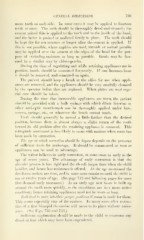Page 711 - My FlipBook
P. 711
GENERAL DIRECTIONS. 709
more teeth on each side. In some cases it may be applied to fourteen
teeth at once. The teeth shoukl be thoroughly dried and cleaned ; the
cement mixed thin is applied to the tooth and to the inside of the band,
and the latter is pushed or malleted firmly to place. The teeth should
be kept dry for ten minutes or longer after the cement is applied. If
this is not possible, where napkins are used, varnish or melted paraffin
may be applied over the cement at the edges of the band for the pur-
pose of excluding moisture as long as possible. Bands may be fast-
ened in a similar way by chloro-percha.
During the time of regulating and while retaining appliances are in
position, bands should be examined frequently. If one becomes loose
it should be removed, and cemented on again.
The patient should keep a brush at the office for use when appli-
ances are removed, and the appliances should be very carefully cleansed
by the operator before they are replaced. When plates are used espe-
cial care should be taken.
During the time that immovable appliances are worn, the patient
should be provided with a bulb syringe with which dilute listerine or
other antiseptic mouth-wash can be thoroughly applied under bars,
screws, springs, etc., or wherever the brush cannot reach.
Teeth should generally be moved a little farther than the desired
position, because there is almost always a slight return of the tooth
toward its old position after the retaining appliance is removed. This
retrograde movement is less likely to occur with canines when room has
been made by extraction.
The age at ichich correction should be begun depends on the presence
of sufficient teeth for anchorage. It should be commenced as soon as
appliances can be used to advantage.
The writer believes in early correction, in some cases as early as the
age of seven years. The advantage of early correction is that the
alveolar process is less rigid and the alveoli larger than when the child
is older, and hence less resistance is offered. At the age mentioned the
deciduous molars are firm, and in some cases remain so until the child is
ten or twelve years of age. (See page 712 and following pages for cases
that demand early treatment.) At an early age new tissue is built up
around the tooth more quickly, as the osteoblasts are in a more active
condition; hence retaining appliances need not be worn so long.
Teeth tend to more into their proper jxmtionH if room is made for them.
This seems especially true of the canines. In many cases after extrac-
tion of a first bicuspid the canine will move to its place without assist-
ance. (See Figs. 723 and 724.)
Sufficient explanation should be made to the child to overcome any
dread or fear which may have been engendered.


